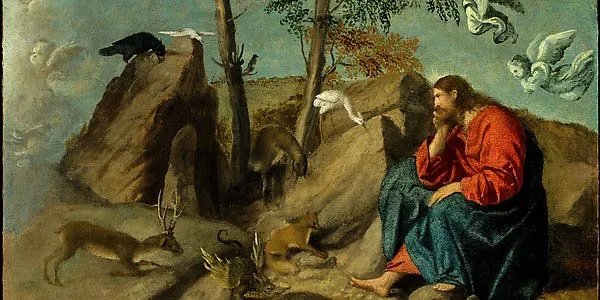Jesus and The Wild Animals
We are well into Lent now - forty days set apart by the Church for repentance, prayer and fasting. These forty days are meant to mirror the days which Jesus spent in the wilderness praying and enduring Satan’s temptations. Jesus’ sojourn was a mystical participation with, or perhaps the perfect fulfillment of the forty years Israel wandered in the Wilderness of Sin facing hunger and temptations of many kinds. Jesus did not choose the desert anymore than the Israelites chose it. Scripture says that the Holy Spirit “drove” him there. The Greek word is ekballo. It is a strong verb - the same verb used for exorcising demons. Apparently, the Father had urgent business for His Son in the desert. Jesus had to be proven through hunger and temptation, passing a more rigorous test than His forebearers had known. Jesus’ rejection of Satan is one of the many ways by which Jesus brought Israel’s calling to perfection. It was a sign by which He demonstrated His identity as the Messiah. The writer of Hebrews explains it this way: “Although He was a Son, He learned obedience from the things which He suffered. And having been perfected, He became the source of eternal salvation for all those who obey Him.” Hebrews 5:8-9
The parallels of Jesus’ forty days of temptation with Israel’s sojourn in the desert would be difficult to overstate; and yet, the imagery in Mark’s account harkens back even further - back to the Garden of Eden in the fall of Man. Eve was tempted much like Jesus. She met the Accuser face to face. She fell for his lies, as did Adam, and they were driven out from Eden. (like Jesus was driven into the wilderness.) With the expulsion of Adam and Eve, all of creation fell into disorder. The animals which Adam had named turned wild. They became a threat to the very people who were supposed to be their stewards. There was enmity between Eve and the serpent. Plagues of locusts, frogs and gnats inflicted upon Egypt. Wild jackals, lion and bears threatened both sheep and shepherds. Scorpions stung men and frightened children. Creation was marred with death and violence.
Mark’s gospel includes a fascinating detail left out of Matthew’s much longer account of Jesus’ temptation. It says that and “He was with the wild animals.” Jesus went and sat in the desert - in the pain of our sin - in the groaning of creation itself. I wonder how the animals felt with the Messiah in their midst? Were they drawn to Him? Did they threaten Him as they would any other man? Did they respond in mixed ways, like men responded to their King? Whatever the animals may have “felt” or “recognized” in their own animal way, we know that they did not dare harm Jesus. On some level they knew Him to be the Lion of Judah - the king of all beasts.
But Jesus is also a Lamb. I wonder if the wild animals sensed His vulnerability? I wonder if Jesus felt it Himself? Did He shudder at all when he saw a scorpion? I rather doubt it, for He did not tremble at all before Caiaphas or Pilate who were like wild beasts in His presence. Jesus knew He was in control even as He was sentenced to death. He laid down His life in accordance with the Father’s will. He was perfectly meek and and King of Creation at the same time.
Thinking a Jesus as a lamb in the wilderness reminded me of Joseph on the day His brothers betrayed him. Jacob sent Joseph out to the wilderness to check on his brothers who were tending the flocks. When the brothers saw Joseph in in his coat of many colors, the sign of Jacob’s favor, they hated him. They tore off his coat, threw him in a pit, and sold him into slavery. Then they dipped Joseph’s robe in blood and told their father that a wild animal had torn Joseph to pieces.
This was a false accusation of the animals. They were innocent in the matter. Noentheless, Jospeh served as a sort of sacrificial lamb - a prefigure of Christ. The Lord turned what Jospeh’s brothers meant for evil into good. Joseph was given favor which not only saved his brothers, but the whole world. And through Joseph’s figurative “death” and “resurrection,” his wayward brothers were reconciled with their father.
I love the image of the Lamb of God lying down with the lions in the wilderness. I love the fact that Jesus was always reconciling all things to Himself, even the wild beasts. He is both the Lamb that was Slain and the Lion of Judah. He is both the Lamb of God, a sheep like the rest of us, and the Good Shepherd leading us Home. He is both God and Man - able to sympathize with our weaknesses, and able to save us from them.
When Jesus returns He will wear a robbed dipped in blood, like Joseph’s robe. “And on His robe and on His thigh He has a name written: ‘KING OF KINGS, AND LORD OF LORDS.’ “ - Rev. 19:13 And to this King “every created thing which is in heaven, or on the earth, or under the earth, or on the sea, and all the things in them, will say, “To Him who sits on the throne and to the Lamb be the blessing, the honor, the glory, and the dominion forever and ever.” - Rev. 5:13
